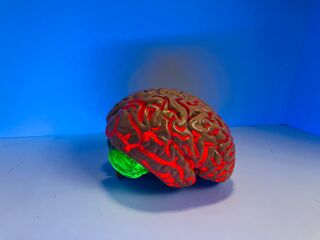Depression
What Happens in the Brain of Someone Both Depressed and Anxious
A new study shows dramatic changes.
Posted August 8, 2020 Reviewed by Devon Frye
Key points
- Someone with both depression and anxiety tends to have more severe symptoms and increased suicidal ideation.
- New research finds that this comorbidity affects brain areas associated with memory and emotional processing.
- The amygdala expands, and this byproduct of anxiety may mask signs of depression.

Neuroscientists have continued delving into the relationship between the brain and mental illness to offer hope to those who suffer. On a global level, depression is the most prevalent and disabling psychiatric disorder—affecting approximately 4.4 percent of the population—with anxiety the second most prevalent psychiatric disorder, according to the World Health Organization.
Depression comorbid with anxiety has been linked to poorer health outcomes, more severe symptoms, and higher levels of suicidal ideation. Previous studies have shown that depression shrinks the part of the brain, the hippocampus, linked to memory and learning. Many people suffer from both depression and anxiety. Yet most of the past studies do not account for patients with both conditions.
A new study from Australian National University, which examined the co-morbidity of anxiety and depression, found that over time the pairing has a profound effect on brain areas associated with memory and emotional processing.
The study, published in The Journal of Psychiatry and Neuroscience, observed people with depression and anxiety to learn the effects of both disorders on the brain. The researchers examined 10,000 people in 112 studies and found what past research has found: that those with depression alone also have lower brain volumes, especially in the hippocampus. According to the study’s authors, this becomes even more relevant later in life because a smaller hippocampus is a risk factor for Alzheimer’s disease and may accelerate the development of dementia. The second finding revealed that when both anxiety and depression occur together, no shrinkage appeared in the hippocampus, and the amygdala—the part of the brain linked to emotions—increased in size.
What does this combined impact on the brain mean? The research team surmised that the pairing of anxiety and depression indicates that anxiety lowers the effects of depression on brain volume size by 3 percent. They concluded that the overactivity of anxiety causes the brain to make more connections and thus become larger. This can be problematic, according to the researchers, because the presence of anxiety along with depression and the enlargement can mask the shrinking effects of depression.
The findings that the brain gets bigger if a patient is both anxious and depressed also imply that the actual effect of depression on brain shrinkage has been underestimated because of the opposite masking effect in the amygdala. The investigators emphasized the need for future studies that examine anxiety comorbidity as a means to better understand the independent role of each disorder in brain structure. The findings further highlight the need for effective treatments to improve long-term mental health and prevent additive effects to neurocognitive disorders later in life.
Facebook images: fizkes/Shutterstock; TheVisualsYouNeed/Shutterstock. LinkedIn image: Rocketclips, Inc./Shutterstock
References
Oyarce, D. E., et al. (2020). Volumetric brain differences in clinical depression in association with anxiety: a systematic review with meta-analysis, Journal of Psychiatry and Neuroscience, DOI: 10.1503/jpn.190156
World Health Organization. (2017). Depression and other common mental disorders: global health estimates. Geneva: World Health Organization.


